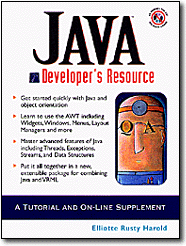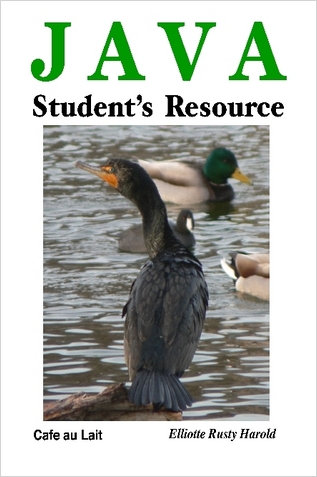
My very first book was the Java Developer's Resource. It was sort of amateurish, made lots of mistakes that make me cringe when I read it now, never earned out, and generally died an unheralded death; but it was the early days, and nobody else knew any better back then either. It did succeed in getting me my first university teaching job, and it did become the basis for the Java course notes I've published here for the last nine years or so.
Unlike the book, which is long since out of print, I have been updating and adding to the course notes over time. In fact, there's relatively little of the original book left at this point. It's actually become a fairly solid introduction to Java at roughly the level of Java 1.4. Professors at quite a few other universities have used my notes to teach Java, and even more individuals have used them for self-study. I probably should add some more Java 5 material to cover generics and the collections API, but at this point I'm limited by how much I can cram into one semester. Every subject I add means there's one thing I have to take out. A few topics in the later parts of the notes I haven't gotten to since the first or second semester I taught the course way back in the 1990s.
Periodically I receive requests for a unified bundle of the notes that's easy to install on a laptop and read in the dorms, at the library, the beach, the coffee shop, the local tavern, or wherever else people study. I tried selling zip files with HTML but:

- People post the notes on their own web sites, and then I get bug reports about problems I can no longer fix.
- A lot of people really seem to want a single, printable file; especially a PDF.
- I'm really, really bad at doing my own fulfillment.
Hence I am pleased to announce that I have teamed up with Lulu.com to make the course notes available for purchase in both printed and PDF form under the title the Java Student's Resource. A PDF is $19.95. A perfect-bound, printed copy is $35.90. All major credit cards are accepted. Now I can concentrate on what I like to do (writing and teaching) and Lulu will handle the mundane details of taking credit card numbers and shipping boxes.
The printed book is not available from other retailers such as Amazon. I thought about making it available there, but the tyrannies of ISBN numbers would have kept me from updating it as frequently as I like. Lulu doesn't tell me who ordered the book, but if you drop me an e-mail after you've ordered it, I'll put you on a mailing list to receive free updated versions of the PDF as they're released, probably 2-4 times a year. Enjoy!